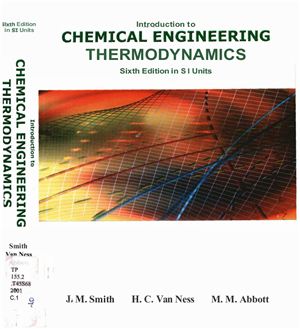6th ed. in SI Units. McGraw Hill. 2001. 749 p.
Introduction to Chemical Engineering Thermodynamics, 6/e, presents comprehensive coverage of the subject of thermodynamics from a chemical engineering viewpoint. The text provides a thorough exposition of the principles of thermodynamics and details their application to chemical processes. The chapters are written in a clear, logically organized manner, and contain an abundance of realistic problems, examples, and illustrations to help students understand complex concepts. New ideas, terms, and symbols constantly challenge the readers to think and encourage them to apply this fundamental body of knowledge to the solution of practical problems.
The comprehensive nature of this book makes it a useful reference both in graduate courses and for professional practice. The sixth edition continues to be an excellent tool for teaching the subject of chemical engineering thermodynamics to undergraduate students.
Contents
Introduction
The First Law and Other Basic Concepts
Volumetric Properties of Pure Fluids
Heat Effects
The Second Law of Thermodynamics
Thermodynamic Properties of Fluids
Applications of Thermodynamics to Flow Processes
Production of Power from Heat
Refrigeration and Liquefaction
Vapor/Liquid Equilibrium: Introduction
Solution Thermodynamics: Theory
Solution Thermodynamics: Applications
Chemical-Reaction Equilibria
Topics in Phase Equilibria
Thermodynamic Analysis of Processes
Introduction to Molecular Thermodynamics
Introduction to Chemical Engineering Thermodynamics, 6/e, presents comprehensive coverage of the subject of thermodynamics from a chemical engineering viewpoint. The text provides a thorough exposition of the principles of thermodynamics and details their application to chemical processes. The chapters are written in a clear, logically organized manner, and contain an abundance of realistic problems, examples, and illustrations to help students understand complex concepts. New ideas, terms, and symbols constantly challenge the readers to think and encourage them to apply this fundamental body of knowledge to the solution of practical problems.
The comprehensive nature of this book makes it a useful reference both in graduate courses and for professional practice. The sixth edition continues to be an excellent tool for teaching the subject of chemical engineering thermodynamics to undergraduate students.
Contents
Introduction
The First Law and Other Basic Concepts
Volumetric Properties of Pure Fluids
Heat Effects
The Second Law of Thermodynamics
Thermodynamic Properties of Fluids
Applications of Thermodynamics to Flow Processes
Production of Power from Heat
Refrigeration and Liquefaction
Vapor/Liquid Equilibrium: Introduction
Solution Thermodynamics: Theory
Solution Thermodynamics: Applications
Chemical-Reaction Equilibria
Topics in Phase Equilibria
Thermodynamic Analysis of Processes
Introduction to Molecular Thermodynamics

